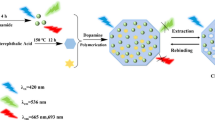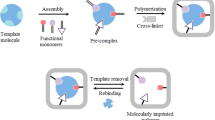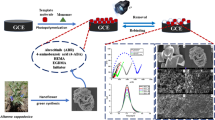Abstract
Molecularly imprinted polymers (MIPs) exhibit high selectivity resulting from imprinted cavities and superior performance from functional materials, which have attracted much attention in many fields. However, the combination of MIPs film and functional materials is a great challenge. In this study, hemin/graphene hybrid nanosheets (H-GNs) were used to initiate the imprinted polymerization by catalyzing the generation of free radicals. Thus, MIPs using sulfamethoxazole as the template was directly prepared on the surface of H-GNs without any film modification. Most importantly, the template could be absorbed on the H-GNs to enhance the number of imprinted sites per unit surface area, which could improve the selectivity of MIPs film. Thus, the composites could exhibit high adsorption capacity (29.4 mg/g), imprinting factor (4.2) and excellent conductivity, which were modified on the surface of electrode for rapid, selective and sensitive detection of sulfamethoxazole in food and serum samples. The linear range was changed from 5 μg/kg to 1 mg/g and the limit of detection was 1.2 μg/kg. This sensor was free from interference caused by analogues of sulfamethoxazole, which provides a novel insight for the preparation of MIPs-based sensor and its application in food safety monitoring and human exposure study.
Similar content being viewed by others
References
Sasanya JJ, Okeng JWO, Ejobi F, et al. Use of sulfonamides in layers in Kampala district, Uganda and sulfonamide residues in commercial eggs. Afr Heal Sci, 2005,5(1):33–39
Abdellatif AL, Aziz A. Mini–review: Recent Advances in Electrochemical Determination of Sulfonamides. Anal Lett, 2018,51(3):424–441
Dmitrienko SG, Kochuk EV, Apyari VV, et al. Recent advances in sample preparation techniques and methods of sulfonamides detection–A review. Anal Chem Acta, 2014,850:6–25
Hoff RB, Rübensam G, Jank L, et al. Analytical quality assurance in veterinary drug residue analysis methods: Matrix effects determination and monitoring for sulfonamides analysis. Talanta, 2015,132:443–450
Ramnani P, Saucedo NM, Mulchandani A. Carbon nanomaterial–based electrochemical biosensors for label–free sensing of environmental pollutants. Chemosphere, 2016,143:85–98
Baptista FR, Belhout SA, Giordani S, et al. Recent developments in carbon nanomaterial sensors. Chem Soc Rev, 2015,44(13):4433–4453
Yang Q, Li J, Wang X, et al. Strategies of molecular imprinting–based fluorescence sensors for chemical and biological analysis. Biosens Bioelectron, 2018,112:54–71
Yola ML, Atar N. A Review: Molecularly Imprinted Electrochemical Sensors for Determination of Biomolecules/Drug. Curr Anal Chem, 2017,13(1):13–17
Yanez–Sedeno P, Campuzano S, Pingarron JM. Electrochemical sensors based on magnetic molecularly imprinted polymers: A review. Anal Chem Acta, 2017,960:1–17
Ansari S. Combination of molecularly imprinted polymers and carbon nanomaterials as a versatile biosensing tool in sample analysis: Recent applications and challenges. Trac–Trend Anal Chem, 2017,93:134–151
DaoudAttieh M, Zhao Y, Elkak A, et al. Enzyme–Initiated Free–Radical Polymerization of Molecularly Imprinted Polymer Nanogels on a Solid Phase with an Immobilized Radical Source. Angew Chem Int, 2017,56(12):3339–3343
Guo Y, Deng L, Li J, et al. Hemin–Graphene Hybrid Nanosheets with Intrinsic Peroxidase–like Activity for Label–free Colorimetric Detection of Single–Nucleotide Polymorphism. ACS Nano, 2011,5(2):1282–1290
Zhao Y, Zhang Y, Liu A, et al. Construction of Three–Dimensional Hemin–Functionalized Graphene Hydrogel with High Mechanical Stability and Adsorption Capacity for Enhancing Photodegradation of Methylene Blue. ACS Appl Mat Inter, 2017,9(4):4006–4014
Lei W, Wu L, Huang W, et al. Microwave-assisted synthesis of hemin–graphene/poly(3,4–ethylenedioxythiophene) nanocomposite for a biomimetic hydrogen peroxide biosensor. J Mater Chem B, 2014,2(27):4324–4330
Wang X, Hou C, Qiu W, et al. Protein–Directed Synthesis of Bifunctional Adsorbent–Catalytic Hemin–Graphene Nanosheets for Highly Efficient Removal of Dye Pollutants via Synergistic Adsorption and Degradation. ACS Appl Mat Inter, 2017,9(1):684–692
Li D, Bie Z, Wang F, et al. Efficient synthesis of riboflavin–imprinted magnetic nanoparticles by boronate affinity–based surface imprinting for the selective recognition of riboflavin. Analyst, 2018,143:4936–4943
Zhao Y, Bi C, He X, et al. Preparation of molecularly imprinted polymers based on magnetic carbon nanotubes for determination of sulfamethoxazole in food samples. RSC Adv, 2015,5(86):70309–70318
Kong X, Gao R, He X, et al. Synthesis and characterization of the core–shell magnetic molecularly imprinted polymers (Fe3O4@MIPs) adsorbents for effective extraction and determination of sulfonamides in the poultry feed. J Chromatogr A, 2012,1245:8–16
Turco A, Corvaglia S, Mazzotta E, et al. Preparation and characterization of molecularly imprinted mussel inspired film as antifouling and selective layer for electrochemical detection of sulfamethoxazole. Sensor Actuat B–Chem, 2018,255(3):3374–3383
Zhao Y, Yuan F, Quan X, et al. An electrochemical sensor for selective determination of sulfamethoxazole in surface water using a molecularly imprinted polymer modified BDD electrode. Anal Method, 2015,7(6):2693–2698
Yari A, Derki S. Silver–filled MWCNT nanocomposite as a sensing element for voltammetric determination of sulfamethoxazole. Anal Chim Acta, 2018,1039:51–58
Chen C, Chen YC, Hong YT, et al. Facile fabrication of ascorbic acid reduced graphene oxide–modified electrodes toward electroanalytical determination of sulfamethoxazole in aqueous environments. Chem Eng J, 2018,352:188–197
Author information
Authors and Affiliations
Corresponding author
Additional information
This work was supported by the Entry-Exit Inspection and Quarantine Bureau of China (No. 2016IK118 and No. 2016IK116).
Rights and permissions
About this article
Cite this article
Guo, Sf., Chen, Xy., Wang, P. et al. Preparation of Molecularly Imprinted Composites Initiated by Hemin/Graphene Hybrid Nanosheets and Its Application in Detection of Sulfamethoxazole. CURR MED SCI 39, 159–165 (2019). https://doi.org/10.1007/s11596-019-2014-6
Received:
Revised:
Published:
Issue Date:
DOI: https://doi.org/10.1007/s11596-019-2014-6




